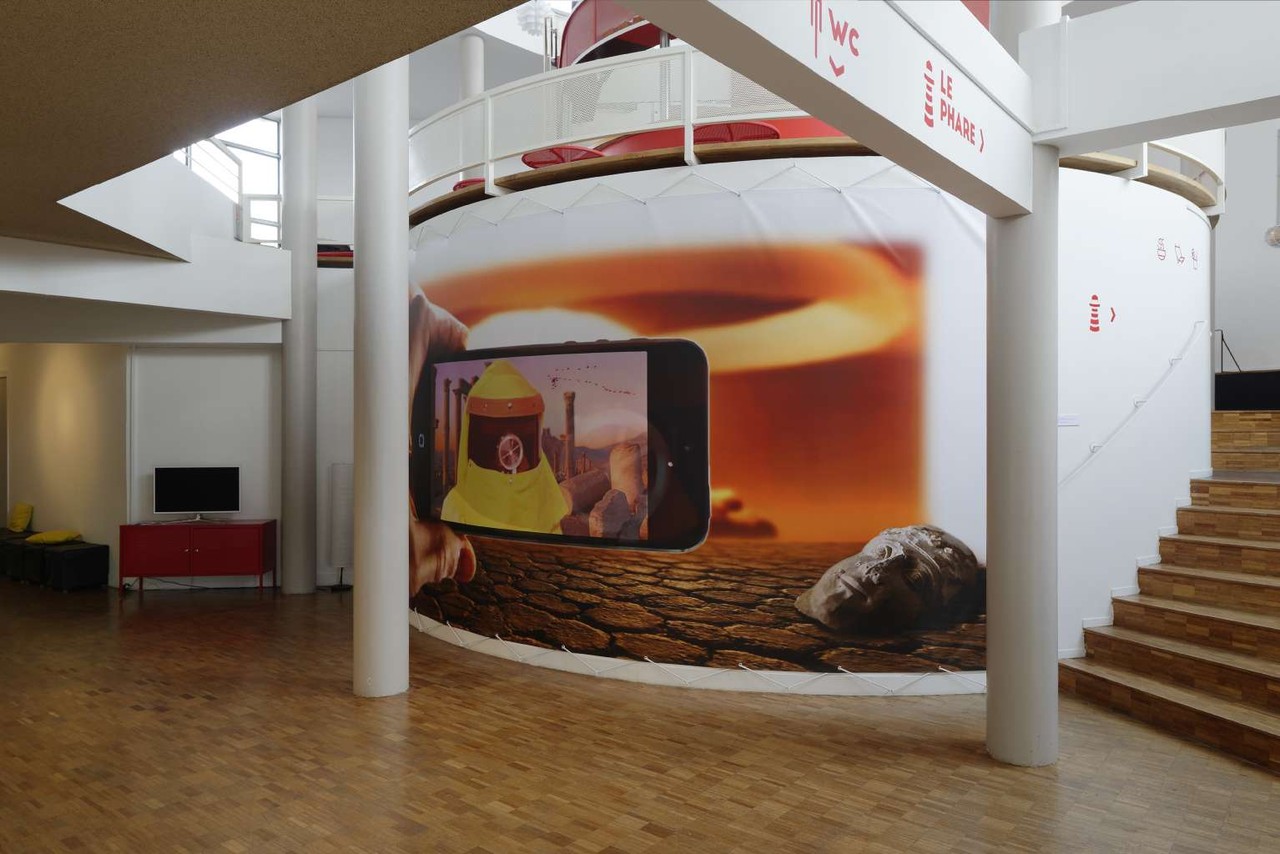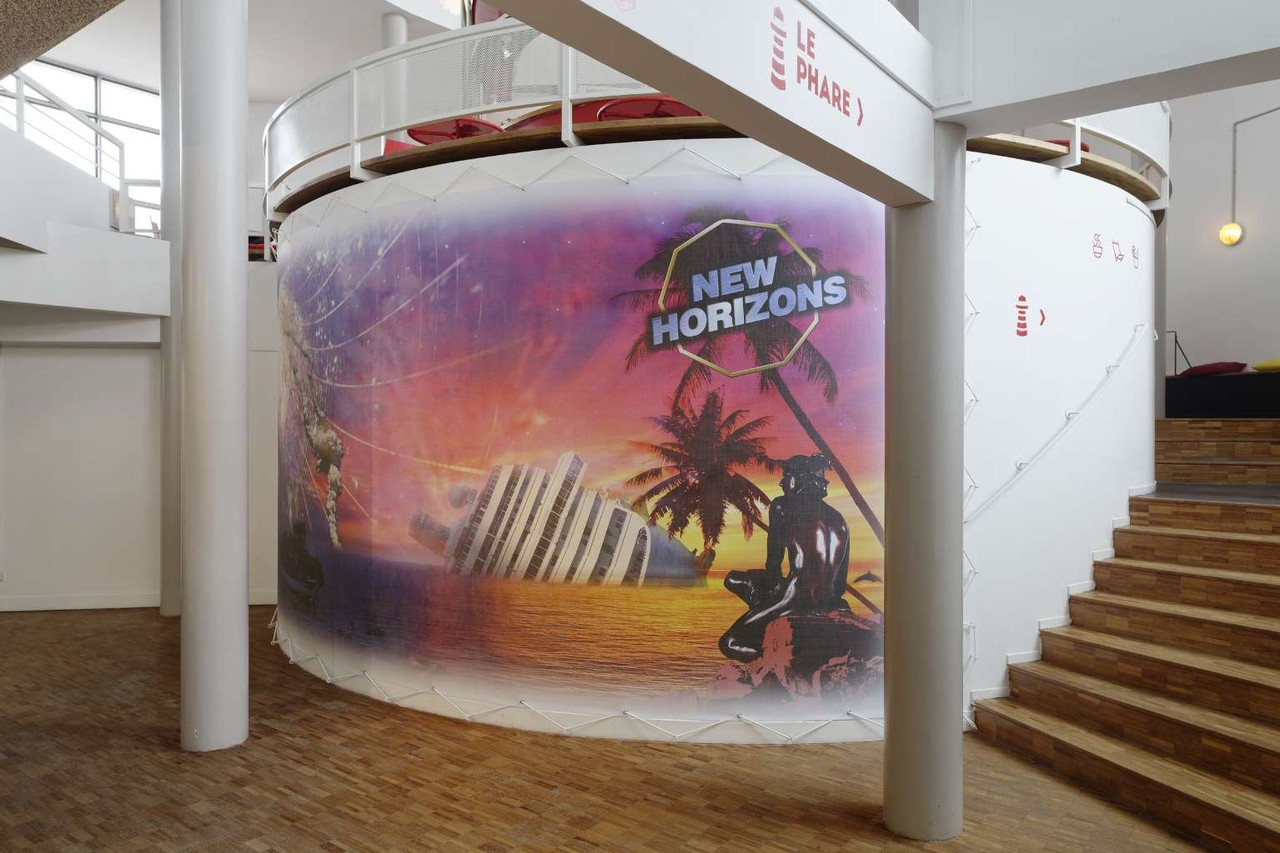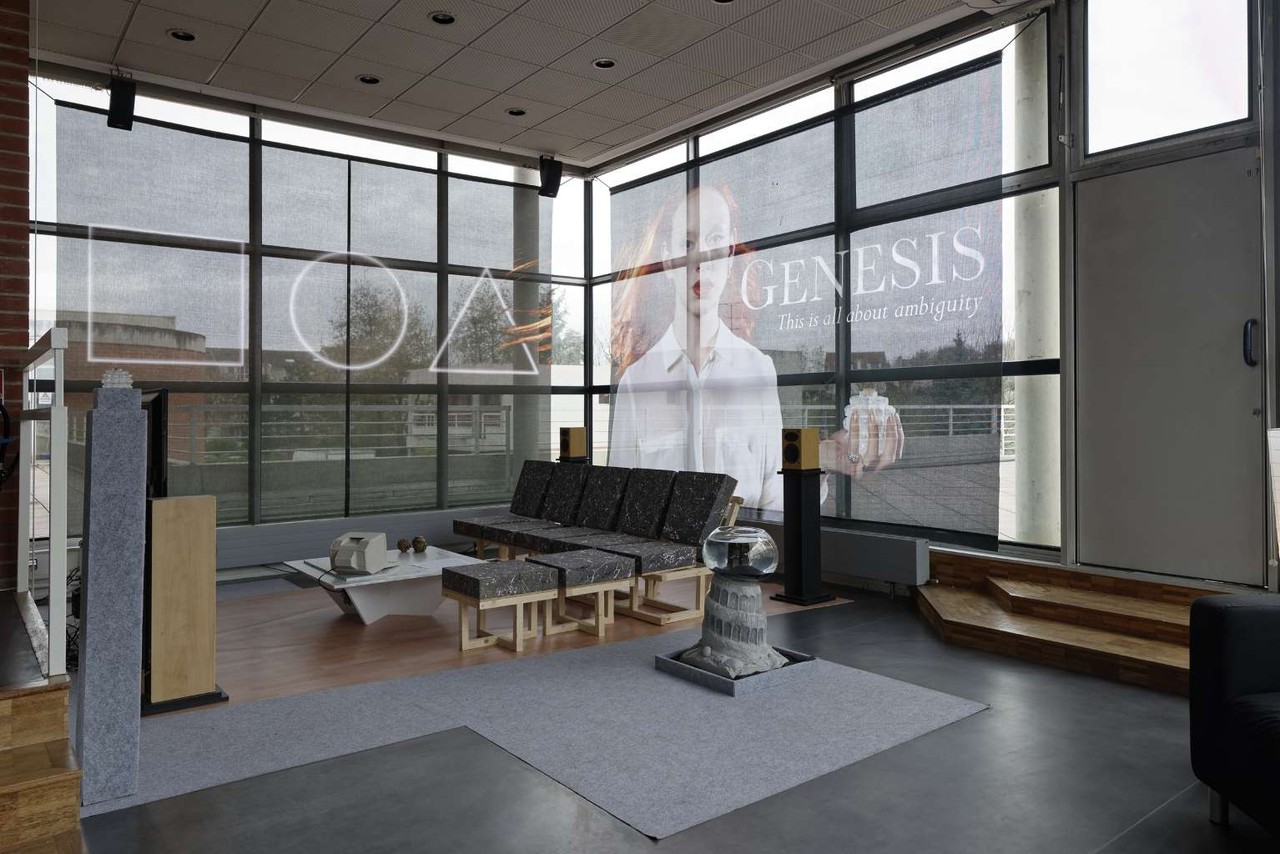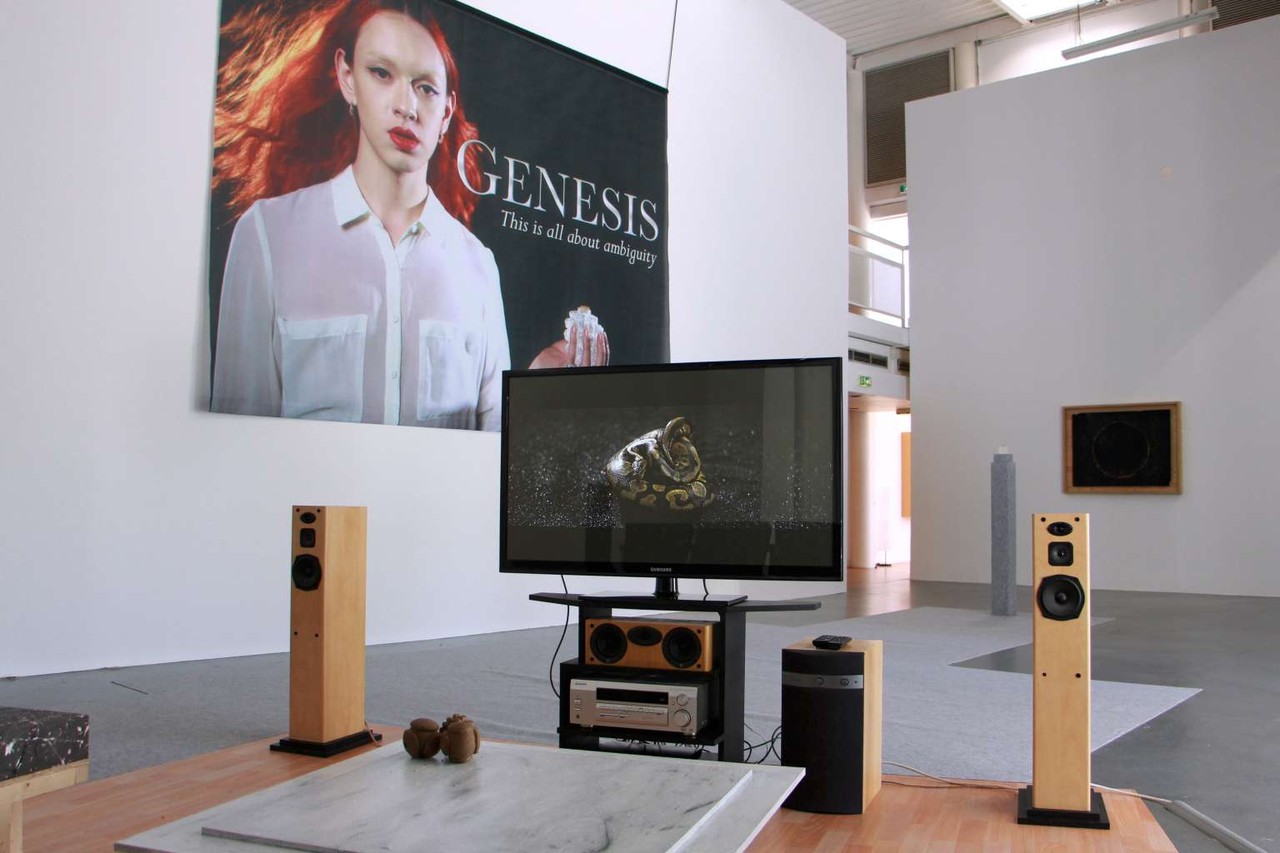Tony Regazzoni
23 Sep 2016 - 01 Jul 2017

Tony Regazzoni, Instadeath, 2017
Produced with the support of CAC Brétigny—Théâtre Brétigny
Photo: © Aurélien Mole
Digital print on PVC, sandows, metal hooks, 640 x 300 cm.
Produced with the support of CAC Brétigny—Théâtre Brétigny
Photo: © Aurélien Mole
Digital print on PVC, sandows, metal hooks, 640 x 300 cm.

Tony Regazzoni, New Horizons, 2016
Produced with the support of CAC Brétigny—Théâtre Brétigny
Photo: © Aurélien Mole
Digital print on PVC, sandows, metal hooks, 640 x 300 cm.
Produced with the support of CAC Brétigny—Théâtre Brétigny
Photo: © Aurélien Mole
Digital print on PVC, sandows, metal hooks, 640 x 300 cm.

Tony Regazzoni, The Lost Opera 3D (Mars), 2017
Produced with the support of CAC Brétigny—Théâtre Brétigny
Photo: © Aurélien Mole
Digital print on adhesive PVC, styrofoam, wood, red curtains, fluorescent lamps, 360 x 480 x 80 cm.
Produced with the support of CAC Brétigny—Théâtre Brétigny
Photo: © Aurélien Mole
Digital print on adhesive PVC, styrofoam, wood, red curtains, fluorescent lamps, 360 x 480 x 80 cm.

Tony Regazzoni, Living on Video, 2016
Produced with the support of CAC Brétigny—Théâtre Brétigny
Photo: © Aurélien Mole.
Produced with the support of CAC Brétigny—Théâtre Brétigny
Photo: © Aurélien Mole.

Tony Regazzoni, Living on Video, 2016
Production CAC Brétigny—Théâtre Brétigny
Photo: © Tony Regazzoni
Production CAC Brétigny—Théâtre Brétigny
Photo: © Tony Regazzoni
TONY REGAZZONI
The Lost Opera
23 September 2016 — 01 July 2017
In collaboration with Théâtre Brétigny, Tony Regazzoni has been working for a year on the patio and hall of the theater, echoing its program.
The Lost Opera (1/3): September—December 2016
In co-production with Théâtre Brétigny. Throughout the year, Tony Regazzoni has been doing on-site work on the patio and in the hall of the theater, echoing the theater’s own program.
The three-part video Genesis is presented for the first time in its entirety within an installation specially designed for the occasion, which reproduces a home interior. While mimicking the succession of images and registers that are normally seen playing out on television, the video is also built around symbols that conjure up cosmogonical myths. The film Genesis was produced with the support of the Fondation Nationale des Arts Graphiques et Plastiques, Drac Île-de-France, Abbaye Royale de Fontevraud and Maison Ackerman in Saumur.
The short scenes of the digital prints, whose interchanging settings and protagonists reenact a certain history of humanity, progress and modernity, are designed as religious and/or symbolic paintings, as well as advertisements for mythological objects or inventions.
The photomontage New Horizons depicts a series of tragic events, such as the explosion of the space shuttle Challenger in 1986 or the shipwreck of Costa Concordia in 2012, against a brightly colored backdrop. In order to celebrate the beliefs of Modern Humanity, these compositions stage its histories and stories, and describe the success and failures that marked its race to progress.
The Lost Opera (2/3): January—March 2017
In response to the theme chosen by the theater for the second part of its season, La Force des Illusions (The Power of Illusions), two 3D low-tech imaging techniques were used for these new creations, i.e., the anaglyph, which prompts the brain to recreate by assimilation an impression of depth and three-dimensional objects, and bas-relief. Viewers are invited to wear glasses with anaglyphic filters (red and blue) to admire an imaginary Martian landscape. Like a theater set, a fresco imitating a crumbled wall covers the technical elements. Playing with the dual illusions of technical devices and composed landscapes, the resulting image conjures up the phantasmagoria of conquering space, and in particular of the conquest of Mars.
A new composition is also on view, welcoming visitors at the entrance of the theater. Like the previous one, it adopts a hybrid form between painting and advertisement that evokes both surrealist paintings and eloquent graphics of publicity banners. The French jet fighter “Mirage 2000”, an American replica of Stonehenge in concrete, the ruin of the Doric tower of the Retz Desert, and even the skull of the Piltdown Man vie to cover the surface of the banner, offering a close connection with simulacra, trompe-l’oeil and illusions.
The Lost Opera (3/3): April—June 2017
Echoing the theme chosen by Théâtre Brétigny for the third part of the season, “À mort la mort” (Death to Death), Regazzoni invites visitors to contrast their ostensible digital immortality with their physical death. To anyone wishing to be a part of his work, Regazzoni proposes putting them in a scene where they can take a selfie while in a dangerous situation or facing imminent death, which they can then share on the social networks via the hashtag #megadeath, the title of his installation. Collected on Instagram or Facebook, the images will remain viewable for an indefinite amount of time, for some maybe even surviving us.
Born in 1982, Regazzoni lives and works in Paris. He graduated from the Ecole Cantonale d’Art de Lausanne in 2006 and from the Ecole Nationale Supérieure de Dijon in 2005. In recent years his work was shown at several solo and group exhibitions, notably at the Galeria Machete (Mexico) in 2016; the Abattoirs—FRAC Midi Pyrénées (Toulouse) and Mains d’œuvres (Saint-Ouen) in 2014; and the Synagogue of Delme in 2012.
The Lost Opera
23 September 2016 — 01 July 2017
In collaboration with Théâtre Brétigny, Tony Regazzoni has been working for a year on the patio and hall of the theater, echoing its program.
The Lost Opera (1/3): September—December 2016
In co-production with Théâtre Brétigny. Throughout the year, Tony Regazzoni has been doing on-site work on the patio and in the hall of the theater, echoing the theater’s own program.
The three-part video Genesis is presented for the first time in its entirety within an installation specially designed for the occasion, which reproduces a home interior. While mimicking the succession of images and registers that are normally seen playing out on television, the video is also built around symbols that conjure up cosmogonical myths. The film Genesis was produced with the support of the Fondation Nationale des Arts Graphiques et Plastiques, Drac Île-de-France, Abbaye Royale de Fontevraud and Maison Ackerman in Saumur.
The short scenes of the digital prints, whose interchanging settings and protagonists reenact a certain history of humanity, progress and modernity, are designed as religious and/or symbolic paintings, as well as advertisements for mythological objects or inventions.
The photomontage New Horizons depicts a series of tragic events, such as the explosion of the space shuttle Challenger in 1986 or the shipwreck of Costa Concordia in 2012, against a brightly colored backdrop. In order to celebrate the beliefs of Modern Humanity, these compositions stage its histories and stories, and describe the success and failures that marked its race to progress.
The Lost Opera (2/3): January—March 2017
In response to the theme chosen by the theater for the second part of its season, La Force des Illusions (The Power of Illusions), two 3D low-tech imaging techniques were used for these new creations, i.e., the anaglyph, which prompts the brain to recreate by assimilation an impression of depth and three-dimensional objects, and bas-relief. Viewers are invited to wear glasses with anaglyphic filters (red and blue) to admire an imaginary Martian landscape. Like a theater set, a fresco imitating a crumbled wall covers the technical elements. Playing with the dual illusions of technical devices and composed landscapes, the resulting image conjures up the phantasmagoria of conquering space, and in particular of the conquest of Mars.
A new composition is also on view, welcoming visitors at the entrance of the theater. Like the previous one, it adopts a hybrid form between painting and advertisement that evokes both surrealist paintings and eloquent graphics of publicity banners. The French jet fighter “Mirage 2000”, an American replica of Stonehenge in concrete, the ruin of the Doric tower of the Retz Desert, and even the skull of the Piltdown Man vie to cover the surface of the banner, offering a close connection with simulacra, trompe-l’oeil and illusions.
The Lost Opera (3/3): April—June 2017
Echoing the theme chosen by Théâtre Brétigny for the third part of the season, “À mort la mort” (Death to Death), Regazzoni invites visitors to contrast their ostensible digital immortality with their physical death. To anyone wishing to be a part of his work, Regazzoni proposes putting them in a scene where they can take a selfie while in a dangerous situation or facing imminent death, which they can then share on the social networks via the hashtag #megadeath, the title of his installation. Collected on Instagram or Facebook, the images will remain viewable for an indefinite amount of time, for some maybe even surviving us.
Born in 1982, Regazzoni lives and works in Paris. He graduated from the Ecole Cantonale d’Art de Lausanne in 2006 and from the Ecole Nationale Supérieure de Dijon in 2005. In recent years his work was shown at several solo and group exhibitions, notably at the Galeria Machete (Mexico) in 2016; the Abattoirs—FRAC Midi Pyrénées (Toulouse) and Mains d’œuvres (Saint-Ouen) in 2014; and the Synagogue of Delme in 2012.
